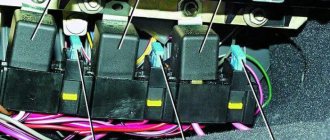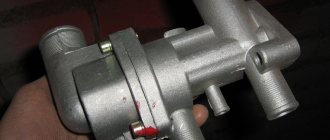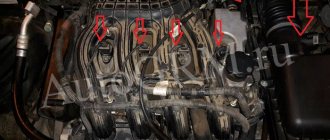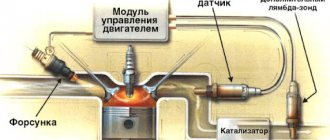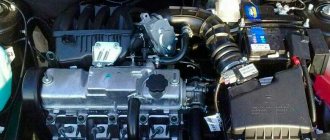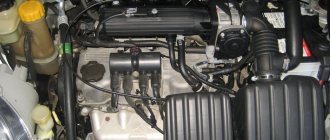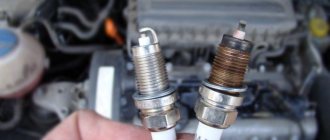Advantages of a sixteen-valve engine
Design features make the 16 valve VAZ 2112 engine such an attractive choice for motorists.
Pros of the 16-valve engine:
- fuel economy;
- higher power;
- detonation resistance;
- advanced cooling system;
- simple tuning due to the separation of the intake and exhaust tracts.
It is the separation between the intake and exhaust tracts in the design of the VAZ-21120 and 21124 engines that makes it possible to achieve quite noticeable fuel savings. Thus, the supply of fuel and the intake of exhaust gases is carried out by a separate spaced valve system, due to which there is no unwanted mixing of fuel and combustion products. It is also obvious that this increases the efficiency of the engine and its power.
The operation of the cooling system of such devices is also pleasing with high stability. This is the most important factor ensuring long engine operation and reliability during its operation. Effective heat removal allows the internal combustion engine to operate at a given temperature, preventing premature wear.
Are the benefits of 16 valves significant enough for you? But that is not all.
Technical specifications
Let's consider the technical characteristics of 8 and 16 valve engines using the example of VAZ models.
Similar article 123 Mercedes engine
| Technical specifications | VAZ 21116 | VAZ 21126 |
| Number of cylinders | 4 | 4 |
| Number of valves | 8 | 16 |
| Volume, cm3 | 1596 | 1597 |
| Cylinder diameter, mm | 82 | |
| Piston stroke, mm | 75,6 | |
| Compression ratio | 10,5 | 11,0 |
| Power, hp at rpm | 87/5100 | 98/5600 |
| Torque, Nm at rpm | 140/3800 | 145/4000 |
| Petrol | AI-95 | |
| Mixed consumption, l/100 km | 7,3 | 7,0 |
What is better, an 8 or 16 valve engine? According to technical indicators, the 16-valve engine wins in power and efficiency, but it is worth taking into account the costs that will have to be incurred for using dynamics and comfort.
When buying a car aftermarket, you can distinguish a 16-valve engine by its appearance. The engine's wide intake manifold resembles a snail, and is usually covered by a shroud with the company logo and the inscription 16Valve.
Tuning the internal combustion engine cylinder block, converting the 8-valve VAZ-2110 (2112) engine to a 16-valve one.
Tuning consists of replacing the cylinder head with a new one. But in this case, the car will have two camshafts, and you will also have to rack your brains over the fastening system, because the diameters of the holes in the 16 valve head do not correspond to those in the 8 valve head.
The mounting holes of the block head should be drilled, increasing the diameter from 10 to 12 millimeters.
You can do this yourself, but it is better to contact a specialized workshop. For this kind of work they should not charge more than 3-4 hundred rubles. It should also be taken into account that the standard mounting bolt for the 16-valve cylinder block is slightly smaller than that for the “eight” and must be shortened accordingly.
It is better to study in advance what a 16-valve engine is like on a VAZ 2110 and then you will certainly be able to carry out this kind of tuning yourself. It will be necessary to change the timing belt, pump pump, rollers, wiring, spark plugs, connecting rod mechanism and other structural elements due to the peculiarity of the cylinder head. The head is assembled separately before installation on the engine. After completing the work, it is also advisable to use specialized services for setting up and calibrating the operation of the internal combustion engine.
Exhaust manifold tuning
Replacing the standard exhaust manifold with an alternative type “Spider” 4-1 or 4-2-1 is a fairly effective and at the same time cheap way to significantly increase the power of your VAZ-2110 car. This part costs about 2000 rubles. When purchasing, you should clarify which car models the product is intended for.
Exhaust manifold 4-2-1 The “Spider” sports exhaust manifold for VAZ-2110 (2112) cars is considered more technologically advanced, providing the most efficient removal of exhaust gases from the internal combustion engine. In addition, it is recommended to purchase an additional direct-flow type resonator and a muffler for it. This way you can avoid welding work and significantly simplify the tuning task.
The replacement process is relatively long and will take you about 4 hours; it is also advisable to carry out the work with someone else’s help, this greatly facilitates and speeds it up. You will need to remove the stock exhaust manifold and exhaust pipe. You can dismantle them as an assembly. After installing the “spider”, the replacement process can be considered complete.
What to do?
The cause of the trouble can be considered to be imperfect engine design. In order to avoid the problem, on a VAZ-21124 type engine there are special recesses (countersets) on the pistons, thanks to which the valves do not bend against the pistons, encountering them when the timing belt breaks. On the earlier model of the 16 valve engine (21120), released two years earlier (in 2002), such notches, alas, are absent.
Otherwise, it’s not a big deal and you can insure yourself against misfortune by making the appropriate holes yourself, for example, during a major overhaul of the engine, or by specially disassembling it and removing the pistons from the cylinders. It will be enough to increase the depth of the counterbores by 2.5 mm. work is performed using a milling machine.
If you are afraid of the need to thoroughly disassemble the internal combustion engine, there is a simpler method thanks to the special PP-12 device. Now you just need to remove the cylinder head and you can perform milling by reading the operating instructions for the device. However, this device is far from cheap, so it would be best to seek help from a specialized workshop, where they will carry out all the necessary work.
At the same time, the size of the combustion chamber increases slightly and the compression ratio decreases. We receive a derated VAZ-2110 engine. The power of the internal combustion engine drops somewhat.
On the other hand, performance characteristics are increased, and now the car can be filled with 92 gasoline and not worry about a torn timing belt. Agree, the benefits definitely pay for the costs.
The VAZ 2112 was equipped with 8 and 16 valve engines. As practice has shown, the 16-valve system is much better. First of all, this is due to fuel consumption and the reliability of the power unit.
The birth of the “gear”: how 16-valve VAZ engines survived to this day
Trends of the times
Using the unit base and the G8 platform for the new model, Tolyatti understood that by the time mass production of the VAZ-2110 started, the “eighth” engine would inevitably become obsolete.
After all, since the beginning of the eighties, environmental requirements in the world have become more stringent, and the liter capacity has constantly increased. The “charged” modifications of the Volkswagen Golf MKII and Opel Kadett E were practically twice as powerful as the basic versions (and the domestic Samara!), because their engines produced 130-140 “horses”! In addition, it became clear that the engine should not only be more powerful and environmentally friendly, but also more economical than its predecessor. Articles / History Ours took: how and why the VAZ-2101 received an overhead engine In the mid-sixties, an epoch-making event took place in the USSR - the construction of a new automobile plant began to produce a licensed version of the Fiat 124. Contrary to popular belief, “Russian... 25053 3 18 02/11/2018
This could be achieved in several ways. Firstly, VAZ unconditionally accepted the transition to a more modern distributed injection , which theoretically made it possible to comply with any emissions cleanliness standards that were relevant at that time.
Secondly, it was necessary to increase the liter power in order to increase the number of “horses” under the hood, while remaining at the same working volume. After all, not in all countries of the world buyers welcomed “large” engines due to taxes. Yes, and NAMI strictly defined the “liter range” of Soviet technology - VAZs had to fit into the range of 1.2-1.6 liters.
At that time, two ways to “cheer up” had already been tested in practice in the world - installing a turbocharger or switching to a multi-valve cylinder head, where the number of intake and exhaust valves for each cylinder was doubled. Having weighed all the pros and cons, VAZ settled on the second option, since supercharging would require much greater costs and technological innovations, while the scheme with four valves per cylinder was otherwise (“lower”) not much different from eight-valve engine, and due to better filling of the cylinders, the power and torque indicators, all other things being equal, should have increased by 10-15%. This means that, coupled with the “injector”, it was actually possible to extract at least 90 hp from a one and a half liter engine.
Porsche again
Having no personal experience in designing such structures, the VAZ team turned to Porsche specialists “out of old memory.” In addition, the Soviet side needed help from the Germans in aerodynamically fine-tuning the body of the “tens” . The contract signed in 1987 included both aerodynamic work and the development of a 16-valve engine with multipoint injection. At the same time, the working volume remained the same - 1.5 liters.
However, VAZ did not sit idly by, shifting the work of developing a new engine onto the shoulders and hands of German “specialists”! Under the leadership of A. Simulman, a version of a multi-valve block head with cast spark plug wells was assembled - that is, without insert parts.
The design of the 16-valve cylinder head was born in close cooperation with foreign specialists and at the same time turned out to be completely original
The option proposed by Porsche was less technologically advanced - in particular, it required a very complex shaped head gasket, the production of a mold for which Soviet rubber goods specialists simply did not undertake. But the German company Elring, which VAZ specialists contacted, agreed to do everything in four months and 400,000 German marks! Both the first and the second did not suit VAZ at all, so they had to... develop the design using VAZ’s own RTI STC, for which one month and 1,500 rubles were enough.
However, in the future, Porsche specialists had to involve little-known and highly specialized companies from Austria and Italy in the technological development and fine-tuning of the head casting. At the same time, the spark plug wells on early 16-valve engines were plug-in, and starting from the 124th engine they became cast, as originally planned in Tolyatti.
Cylinder head of VAZ-2112 engine
The sixteen-valve head required a serious modernization of the “eight” engine, which, at the request of VAZ, became a kind of blank for the “gear”.
In addition to the sixteen-valve design itself with two camshafts, the 2112 engine was also distinguished by the presence of hydraulic pushers with automatic adjustment of the thermal gap, because only compact “hydrics” made it possible to place another shaft and eight additional valves in the cylinder head. In addition to the gas distribution mechanism, the “twelfth” engine also received original intake and exhaust.
Despite the layout similarity with the 8-valve VAZ-21083 engine, the “top” of the new engine received two camshafts, 16 valves and a number of fundamental differences
The intake manifold on the 16-valve was separated from the exhaust. Initially, the intake was made of light alloy, but on the 1.6-liter engine it became plastic
Porsche specialists immediately doubted whether the block and crankshaft of the former eight-valve engine would be suitable for the new engine - after all, the loads, taking into account the increased power and torque, would inevitably increase. Special bench tests of the VAZ-21083 engine in Germany confirmed that its design and mechanical strength fully allow such “tuning”, but subsequently, to be on the safe side, the counterweights on the crankshaft for injection engines were slightly increased, and when the engine was converted into a 16-valve engine, the block received an important modification: Additional oil channels with nozzles pressed into them appeared in the main bearing supports, thanks to which the piston bottoms are washed with oil under pressure.
The German side also developed and optimized the shape of the combustion chamber, thanks to which, even taking into account the high compression ratio (10.5) on gasoline with an OC of 91-95, the VAZ-2112 engine operated without detonation.
In the early stages of fine-tuning the 16-valve engine, distributed injection components from the German company Bosch, familiar to Porsche specialists, were used, but later (since 1990) the Soviet side began to actively cooperate with the American company GM, switching to the “Gim” system not only for multi-valve engines, but also on conventional eight-valve engines of both the “eighth” and “classic” families. The irony of fate was that five years later VAZ again returned to Bosch injection components on its engines, ceasing cooperation with GM in this direction.
Long labor, short life
For the first time, the “ten” with a new engine was officially demonstrated at the end of 1992 at the Moscow Manege, and in 1994, AvtoVAZ “showed off” a pre-production prototype of the VAZ-2110 at the Paris Motor Show.
The “Ten” with a sixteen-valve engine became a real star of the March 1993 Za Rulem magazine: in addition to the cover, the bright new product was given four first pages
16 valves - so it will be in Russian
As it turned out, under the large plastic cover with the “foreign” inscription “16 VALVE” was hidden exactly the 16-valve VAZ-2112 engine, which developed 94 hp. at 5,600 rpm. At the same time, the engine turned out to be quite high-torque - it produced 130 Nm already at 3,600 rpm. Thus, the liter power of the new engine was 62 hp. - not the worst indicator by the standards of the early nineties. At least, European and Japanese analogues with a similar engine design developed approximately 65-70 hp. per liter of working volume.
The speedometer doesn’t lie: with a 16-valve valve, the new VAZ model is very close to the 200 mark – especially according to the speedometer. To be precise, the “one hundred and third”, according to the manufacturer, accelerated to 185 km/h
The VAZ-2112 engine was combined with ventilated front brakes and a reinforced transmission
The more powerful engine required strengthening of transmission parts - in particular, the use of a new secondary shaft with increased rigidity, as well as an increase in clutch diameter from 190 to 200 mm.
The 16-valve engine in the top ten, unlike Samara, was already laid out at the layout design level
The production of the VAZ-2110 was planned since 1995 - the first “tens” were assembled at the AvtoVAZ production plant on June 27, but full-scale mass production began only in 1996. At the same time, many of the first “living” cars were equipped not with a newfangled “gear”, but with a banal carburetor (!) engine with the index 2110.
Prototypes and pre-production samples of the VAZ-2110 looked different from commercial vehicles
And the “one hundred and third” (VAZ-21103) with the same one and a half liter 16-valve VAZ-2112 hit the main assembly line only in 2001.
Theoretically, the 16-valve VAZ could fuel the interest of foreign buyers in products from Tolyatti. In practice, the powerful “ten” seriously interested only the domestic consumer
It was planned that the 16-valve engine would also have a “chisel” - sort of a belated response from AvtoVAZ to the Volkswagen Golf GTI.
However, it later became clear that installing this engine under the hood of Samara required modifications to the body that were incompatible with large-scale production, so this idea was later abandoned, and the 16-valve VAZ-2112 engine remained the prerogative of the “tenth” family.
However, 16-valve engines under the hood of Samar still “leaked”: Tolyatti JSC “Super-Avto” produced VAZ-2113 and VAZ-2114 in “improved configuration”, which included 1.6-liter engines (21124 and 21126) with four valves per cylinder. Almost 100 forces allowed the “super-chisels” not only to compete on an equal footing with the rest of the VAZ sixteen-valve engines, but also to engage in traffic light races with budget foreign cars.
1 / 5
2 / 5
3 / 5
4 / 5
5 / 5
The one and a half liter sixteen-valve engine with index 2112 is easily distinguished by the light color of the intake manifold peeking out from under the plastic cover
However, the “pure twelfth” engine did not last on the assembly line for so long - less than five years, which is especially surprising for VAZ with its long-lived engines. It’s just that in the future, the designers decided to increase the working volume of both the eight- and sixteen-valve “ten” engines to 1.6 liters, which was achieved by installing a higher cylinder block and increasing the piston stroke from 71 mm to 75.6 mm. The new 16-valve engine received the index 21124 - it is popularly known as the “124th engine”. Its important difference from the first sixteen-valve VAZ is the “plug-in piston”: that is, when the timing belt breaks, the valves no longer meet the pistons. Interestingly, the 1,300 cc V8 engine developed by the Germans was also plug-in, but with an increase in displacement to 1.5 liters, this drawback was eliminated on the eight-valve versions (21083/2111).
The 124th engine differed from the first sixteen-valve engine in its increased displacement. Visually, the motor is easy to distinguish by its plastic intake module
An increase of 100 cubic meters of working volume made it possible not only to correct this design feature of the VAZ-2112 engine, but also to painlessly switch to Euro-3 standards without a noticeable deterioration in maximum power and torque.
Immortal "shesnari"
Subsequently, the sixteen-valve engine, along with the eight-valve 21114, was also used on Kalina , since all these front-wheel drive Ladas were created on a common platform .
Like the “ten”, in ten conveyor years Kalina managed to try on two “gears” of different sizes
But the story didn’t end there! the Priora VAZ-2170, released in 2007, the 16-valve engine was once again modernized using a new lightweight connecting rod and piston group from Federal Mogul.
1 / 4
2 / 4
3 / 4
4 / 4
The real “maximum speed” of the 16-valve Priora is 183 km/h
Because of this, the 124th and 126th engines differed in cylinder processing technology, as well as in the design of the head itself, which was associated with the use of a new timing belt tensioning mechanism from Gates. AvtoVAZ declared a maximum power of 98 hp for this engine, although during unofficial bench tests of the “one hundred and twenty-sixth” it was found that in practice it produces more - 102-107 “horses”. By the way, this is exactly how much the current 1.6-liter 16-valve engine with index 21127, which is structurally different from its predecessor, is officially developing for the Priora, Kalina and Granta, which is structurally different from its predecessor with a controlled air intake system.
In the same 2007, the sixteen-valve engine range was replenished with another option - the 1.4-liter engine 11194.
1.4-liter 16-valve VAZ-11194
Structurally, it had much in common with the 126th engine - in particular, the same lightweight piston group, but due to the cylinder diameter reduced to 76.5 mm, the working volume decreased to 1.4 liters, and the maximum power - to 89 hp. With. “Downsizing” of the Kalina engine was done with the aim of improving the fuel efficiency of the car, which, although it shared a platform with the “ten” and Priora, formally still belonged to a slightly lower class, as indicated by the model index, which began with the number 1, and not 2, as the rest have front-wheel drive. In practice, it turned out that the 1.4-liter engine has no noticeable consumer advantages over a conventional eight-valve engine.
Eight-valve alternative: along with the 16-valve, both the “ten”, Kalina, and Priora were also equipped with conventional engines with two valves per cylinder
Alas, both of these engines again received a “plug-in” piston group - that is, a design feature characteristic of the first 16-valve VAZ-2112. However, we must admit that by the standards of its time, this engine turned out to be no less successful than the eight-valve engine of the 2108 family, thanks to which the latest Lada models like Vesta, with a displacement increased to 1.8 liters, still drive with direct engine compartment heirs of that very “gear” "
Survey
What do you think is the secret to the longevity of these engines?
Your voice
Total votes:
Specifications
The 16 valve VAZ 2112 engine, all its versions, have high technical characteristics. There is a lot of debate about the efficiency of powertrains, but the majority of opinions and the number of vehicles sold speaks for itself. The design of the engines is so simple that motorists carry out repairs to the VAZ 2112 engine with their own hands.
VAZ 2112 (engine) came in several versions. This is due to the modernization and release of new power units. So, let's look at what engines were present on the VAZ 2112 with a 16-valve mechanism:
How to install a 16-valve engine on a VAZ 2107
To begin with, you should be well prepared for the procedure:
- enlist the help of two people in advance or connect a hoist to move a heavy motor into the engine compartment;
- dismantle the old engine and all attachments;
- prepare a complete set of wrenches and screwdrivers;
- prepare a hammer and pliers;
- find a good turner to bore the flywheel (on a new engine you will need to remove the flywheel and grind its crown from the inside - this is the only way to ensure free entry of the starter element into the clutch with the flywheel);
Work process
If you are installing an engine from a VAZ 2112 or Lada Priora, then you will not need to change the clutch basket, since the new engine will feel quite comfortable with the old clutch.
After completing all the preparatory work, the actual installation of the 16-valve engine on the “seven” follows:
- Install Niva engine mounts in the engine compartment.
Necessary improvements
However, the installation of a 16-valve engine does not end there. A number of works will be required to improve the entire system. And the best place to start is with electrics.
Electrical refurbishment
For high-quality operation of the new power unit, you will have to replace the gasoline pump. You can take this mechanism from both the Priora and the Twelfth, or you can save money and buy a pump from the injection model of the Seven. The fuel pump is connected according to the usual algorithm and does not require any modifications.
On the VAZ 2107, the motor is connected with only three wires. The new engine requires a qualitatively different connection. First of all, you will need to complete the following steps:
- Install the engine control unit (for example, from the VAZ 2112 model).
- Connect all the sensors included in the kit to it - the wires should be pulled along the same places where they are stretched on the VAZ 2107 (in some cases, the standard wiring will need to be extended).
It is recommended to carry out all connections and new formations on the VAZ 2107 in the same way as they were done on the VAZ 2107 with an injection engine.
Brake system
The new motor has higher power characteristics, which means that the car will accelerate faster and brake slower. In this regard, it is recommended to modify the braking system on the VAZ 2107. To do this, it is enough to replace the main cylinder with a more powerful one, and also, if necessary, replace all the cylinders if they are badly worn.
Cooling system
As a rule, the available potential of the standard cooling system on the “seven” is enough to promptly cool the new powerful engine. However, if the engine lacks cooling, a slight modification will be required: fill the expansion tank not with antifreeze, but with a higher quality antifreeze.
Thus, installing a 16-valve engine on a VAZ 2107 is a complex procedure, as it requires not only significant physical effort, but also thoughtful action. The main difficulty of this operation is connecting the wiring and modifying the system.
Motor VAZ 21120
| Name | Options |
| Brand | |
| Engine capacity | 1.5 (1499 cm cube) |
| Power | 93 hp |
| Type | Injector |
| Fuel | Petrol |
| Valve mechanism | 16 valve |
| Number of cylinders | |
| Fuel consumption | 7.5 liters |
| Econorm | Euro 3 |
| Resource | 180 - 200 thousand km |
Motor VAZ 21124
| Name | Options |
| Brand | |
| Engine capacity | 1.6 16 V |
| Power | 90 hp |
| Type | Injector |
| Fuel | Petrol |
| Valve mechanism | 16 valve |
| Number of cylinders | |
| Fuel consumption | 7.5 liters |
| Econorm | Euro 3 |
| Resource | 180 - 200 thousand km |
Description
The VAZ 21124 engine is part of the line of 16-valve power units produced by AvtoVAZ JSC. It is an in-line 4-cylinder power unit with overhead camshafts and electronic fuel injection (injector).
The gas distribution mechanism is driven by a belt, which must be changed every 45,000 km. At the same time, the manufacturer recommends inspecting it for damage and eliminating sagging every 15 thousand km of the distance traveled.
Read also: International driving license form
The VAZ 21124 engine is assembled on the basis of a tall (197.1 mm) cylinder block modification 11193-1002011, the use of which made it possible to increase the piston stroke to 75.6 mm. This led to an increase in the useful volume of the cylinders to 1.6 liters, torque and power of the power unit.
The developers of the 21124 motor managed to eliminate a significant drawback inherent in many motors. If the drive belt breaks, the power unit does not bend the valve. This was achieved by equipping the pistons with special holes that prevent contact between the piston and the valve in an emergency.
The use of hydraulic pushers made it possible to eliminate the need to adjust valve mechanism clearances. True, at the same time, the sensitivity of the engine to the quality of engine oil has increased.
The features of the VAZ 21124 engine also include:
- absence of high-voltage wires. Instead, a separate ignition coil was installed on each spark plug;
- the presence of special nozzles designed to cool the piston bottoms. They are pressed into bearing supports.
Motor VAZ 21128
| Name | Characteristic |
| Brand | |
| Marking | 1.8 16V |
| Power | 98 horsepower |
| Type | Injection |
| Fuel | Petrol |
| Valve mechanism | 16 valve |
| Number of cylinders | |
| Fuel consumption | 7.5 liters |
| Piston diameter | 82.5 mm |
| Resource | 200 - 250 thousand km |
All power units of the Lada 2112 were equipped with a 5-speed manual transmission.
Service
Maintenance typical for cars produced by AvtoVAZ. The main maintenance operations are changing the oil and oil filter. To change the lubricant, 3.2 liters of engine oil is required. In turn, 3.5 liters of lubricant fits into the engine.
It is recommended to fill in semi-synthetic motor oils marked 5W-30, 5W-40, 10W-40, 15W40. The maintenance map looks like this:
TO-1: Oil change, oil filter replacement. Carry out after the first 1000-1500 km. This stage is also called the break-in stage, since the engine elements are grinding in.
TO-2: The second maintenance is carried out after 10,000 km. So, the engine oil and filter are changed again, as well as the air filter element. At this stage, the pressure on the engine is also measured and the valves are adjusted.
TO-3: At this stage, which is performed after 20,000 km, the standard procedure for changing the oil, replacing the fuel filter, as well as diagnosing all engine systems is carried out.
TO-4: The fourth maintenance is perhaps the simplest. After 30,000 km, only the oil and oil filter element are changed. TO-5: The fifth maintenance is like a second wind for the engine.
This time a lot of things are changing. So, let's look at which elements need to be replaced in the fifth maintenance:
- Change of oil.
- Replacing the oil filter.
- Replacing the air filter.
- Replacing the fuel filter element.
- The timing belt and roller are replaced.
- Alternator belt if necessary.
- Water pump.
- Valve cover gasket.
- Other items that need to be replaced.
- Valve adjustment, which adjusts the gas distribution mechanism.
Subsequent maintenance is carried out according to the 2-5 maintenance map for the corresponding mileage.
Malfunctions and repairs
Although the engines installed on the VAZ 2112 are considered quite durable, they cannot do without breakdown of the power units. So, the most common problems can be considered: the speed fluctuates, the engine stalls or is difficult to start. The reason for this behavior can be various factors. Car enthusiasts mainly prefer to repair a VAZ 2112 engine with their own hands, since it is cheaper.
Over time, the operation of power units, on the first engines, frequent malfunctions of the cooling system were noticed, associated with the performance of the thermostat and water pump. But, on the next generations of engines, this chronic problem was solved.
Consumer characteristics
In addition to power and efficiency, the engine is evaluated in terms of repair and maintenance costs. The ability to improve the performance of the motor also increases its “value”. For example, to increase the engine displacement, the cylinders are bored or the piston stroke is increased.
Repair work
Any engine experiences high load during aggressive driving. Whether it's an 8 or 16 valve engine. Even with proper operation, the power unit has resource limitations. Many of the parts involved wear out and need to be replaced. Frequent problems:
- floating or high idle speed. During diagnostics, the mass air flow sensors, idle air control and throttle valve are checked;
- overheating of the engine may be due to a faulty thermostat, lack of coolant or contamination of the radiator;
- clogged injectors or old spark plugs can cause engine vibration;
- Electrical failures often occur on domestic engines;
- knocking noises under the hood indicate faulty hydraulic lifters, unadjusted pushers or a damaged connecting rod and piston group.
If the engine is equipped with push-in pistons, without grooves on the bottom, a broken timing belt causes the valve stems to bend. To avoid the problem, you need to install a high-quality belt and check its condition every 15,000 km. A safer option is to replace the pistons with non-stick ones.
A drop in compression or an increased appetite for oil is already a reason for a major overhaul, but in practice this happens after 200,000 km. The difference in the cost of major repairs of 8 and 16 valve VAZ engines is 5 - 10 thousand rubles. The average price for a complete overhaul is 8kl. — 35,000 rub.
Similar article Which engine is suitable for the VAZ 2106
Tuning
Engines are tuned to achieve better performance, both 8 and 16 valve units. To achieve high-torque performance of the car, the engine displacement is “increased”:
- Bore the cylinders or increase their number.
- Increase piston stroke.
The most popular method is cylinder boring. However, cutting more than 3 mm from the original size may result in thinning of the walls. This reduces the service life of the part and leads to leaks.
Other tuning options:
- Increasing the number of valves.
- Installation of a sports camshaft for increased power and efficiency.
- Increasing the volume of the exhaust receiver to stabilize the engine.
- Replacing the air filter with a zero filter to increase the amount of incoming air.
- Turbocharged engine.
Tuning
There are two types of VAZ 2112 engine tuning - mechanical and software. The first type involves boring the cylinder block for a new piston group and replacing all parts, such as valves, connecting rods, crankshaft, camshafts, with lightweight ones. This will reduce the weight of the engine, and accordingly increase technical performance and aerodynamics. With proper overhaul of the power unit, the power of the VAZ engine can be doubled.
Do not forget that installing a turbine and direct-flow exhaust on a VAZ will allow you to add an internal combustion engine, a little more power, without changing the volume. It is worth remembering that during mechanical alterations, a new cooling system must be installed, since the old one will not withstand such loads and temperatures. Typically, the operating temperature of a VAZ 211216 valve engine is 87-103 degrees Celsius, and if you leave the old coolant system, it will not cope and the engine will begin to overheat and burn out.
The second option is chip tuning of the VAZ 2112. This is a software upgrade of a car engine. Firmware decoding scheme: Firmware is marked by the manufacturer with an alphanumeric code, divided into 5 groups.
- the first group - the letter and number indicates the type (family) of the controller: J4 - control units (ECU) January-4/4.1;
- J5 - control units January-5.1/5.1.1/5.1.2;
- V5 — control units VS-5.1 (NPO Itelma);
- M1 - Motronic control units M1.5.4 (M1.5.4N); N (New) - new hardware implementation
- M7 - Motronic MP7.0 control units
- V - VAZ cars with front-wheel drive of the 2108, 2110, 2112 families;
For some reason, the exception was firmware for classics, for example, J5V26L52, etc.
- third group - two digits indicate the conditional configuration number (00...99); for front-wheel drive VAZ cars, the following numbers exist: 03 - Euro-2 toxicity standards, 8-valve 1.5L engine;
- 05 — Euro-2 toxicity standards, 16-valve 1.5L engine;
- 07 - Russian standards, 16-valve 1.5L engine;
- 13 - Russian standards, 8-valve 1.5L engine.
- 26 - Russian standards, 8-valve 1.45L engine. Rear-wheel drive (classic).
The new blocks Bosch M7.9.7 and January 7.2 and Mikas 10 have a different, yet unusual identification.
- The first group in them is one letter - manufacturer code I - Itelma
- B - Bosch
- A - Avtel
- 1 - M10
- 03E - project 2111, Euro II
Example:
- B103EQ09 - Bosch, M7.9.7, project 03E, software version - “Q”, calibration number 09
- I203EK34 - Itelma, January 7, project 03E, software version - “K”, calibration number 34
Classification of tuning firmware designations. As a rule, there are no general rules, but this classification scheme for tuning firmware is often used: Calibrations of front-wheel drive VAZs - “V”, replaced by:
- “A” - for firmware for non-standard hardware
- “B” - “Butan” - firmware for working on liquefied gas.
- “C” - “Cam” - firmware for non-standard camshafts.
- “D” - “Dynamic” - for dynamic firmware
- “E” - “Economy” - for economical firmware.
Engine VAZ 21124-100026080. Characteristics of the VAZ 21124 engine.
The VAZ 21124 engine is a four-stroke, injection (distributed fuel injection), the placement of the cylinders in the block is single-row, the camshaft is located in the upper part of the internal combustion engine. The engine is cooled by forced circulation of liquid. Engine components are lubricated by supplying oil under pressure to the mechanisms and by splashing oil.
| Number of cylinders: | 4 |
| Cylinder displacement, l: | 1,599 |
| Compression ratio: | 10,3 |
| Rated power at a crankshaft speed of 5000 rpm: | 65.5 kW.-(89.1 hp) |
| Cylinder diameter, mm: | 82 |
| Piston stroke, mm: | 75,6 |
| Number of valves: | 16 |
| Minimum crankshaft speed, rpm: | 800-850 |
| Maximum torque at 3700 rpm, N*m: | 131 |
| Cylinder operating order: | 1-3-4-2 |
| Octane number of gasoline: | 95(unleaded) |
| Fuel supply system: | Electronically controlled distributed injection. |
| Spark plug: | AU17DVRM, BCPR6ES(NGK) |
| Weight, kg: | 121 |
Engine Features.
What kind of engine was installed: the VAZ 21124 engine can be used for installation on VAZ 2110, VAZ 2111, VAZ 2112 cars and their modifications.
Engine 21124 can be considered as a development option for the sixteen-valve internal combustion engine of the VAZ 2112. The purpose of the modification was to increase the volume to 1600 cm3 (2112 - 1500 cm3) and increase environmental performance to the requirements of European standards.
Cylinder block
The 21124 engine uses cylinder block 11193-1002011. Cylinder diameter – 82.0 mm. Structurally, it differs from the 2112 engine block in height (see “Cylinder block”). The height of block 11193 has increased and is 197.1 mm. (block height 2112 - 194.8 mm). The height of the block is considered to be the distance from the axis of rotation of the crankshaft to the upper surface of the block. The block is painted blue.
The difference between the new block and block 11183 is the use of a different size of holes for attaching the block head (block 11193 has threaded holes M10 x 1.25 mm). In addition, there is another difference, which is the presence of special nozzles pressed into the second, third, fourth and fifth main bearing supports and used to cool the piston crowns with oil while the engine is running.
The VAZ 21124 engine is equipped with a crankshaft 11183 -1005016. The same crankshaft is installed on the VAZ 21126 and VAZ 11194 models. The piston stroke of 75.6 mm is provided by a crankshaft crank with a radius of 37.8 mm. The crankshaft is marked. The inscription “11183” is cast on the sixth counterweight of the shaft.
To drive the gas distribution mechanism, a toothed pulley 2110-1005030 is installed on the crankshaft. The tooth profile of the pulley corresponds to the parabolic tooth of the timing belt. The engine uses a belt 2112-1006040 with a parabolic tooth (25.4 mm wide with 136 teeth). The belt resource is 45 thousand km.
A model 2112 damper is installed on the shaft. The damper performs several functions: through a poly-V-belt it drives the generator and other installed units; the special design of the pulley reduces the impact of torsional vibrations on the shaft; A timing gear located on the damper allows the sensor to determine the angle of rotation of the crankshaft.
Belts
On engines without additional attachments (without a power steering pump and without an air conditioning compressor), a serpentine alternator belt 2110-3701720 6RK742 (742mm) is used.
On engine 21124 with a power steering pump installed, there is a poly V-belt 2110 -1041020 6РК1115 (1115mm).
On the model with an air conditioning compressor - belt 2110-8114096 6РК1125(1125mm).
Piston
New pistons mod are installed on the engine. 21124. The piston is marked accordingly. Compared to the 2112 piston, this piston has a difference. On the bottom of the piston there are four holes for valves. The holes are made with a depth of 5.53 mm. Wells of this depth help prevent contact of the valves with the piston in the event of a timing belt break. On pistons 2112, the wells have a shallower depth: 3.19 mm for the intake and 3.06 for the exhaust.
Rings
Sets of normal size rings of 82 mm are used: 21083-1000100-10 – cast iron or 21083-1004029 – steel rings.
The diameter of the piston pin 21124 is 22 mm, the length of the pin is 60.5 mm. The pin in the piston is installed with a floating fit. Axial fixation is carried out by locking rings.
Read also: Car radios on Android 2 din
Connecting rods and pins from a 2110 engine.
Head
The sixteen-valve cylinder head of the 21124 engine differs from the 2112 cylinder head only in the larger surface area for joining the intake manifold flanges. Two camshafts are installed at the top of the head: one for the intake valves, the other for the exhaust valves. The camshafts, valves, springs and hydraulic lifters remain from the 2112 model. The intake and exhaust camshafts have special marks. The intake camshaft has a raw shoulder near the first cam. In addition, between the second and third cams of the shaft there is a marking in the form of numbers, where the last two digits are “15”. There is no belt on the exhaust camshaft, and the last digits of the number will be “14”.
The installation of hydraulic pushers made it possible to avoid adjusting the gaps in the valve mechanisms. But the hydraulic pusher mechanism is very sensitive to the quality of the oil and its purity. Presence of fur in oil. impurities can lead to failure of the hydraulic pusher. Hydraulic pushers cannot be repaired - they need to be replaced.
The VAZ-21124 cylinder head contains model 2112 valves. The valves have a smaller diameter stem. -7mm (8mm for eight-valve engines). There is only one spring installed on each valve.
The camshafts are driven by a toothed belt from the crankshaft. A toothed pulley is installed on each of the camshafts. The marks for setting the valve timing on toothed pulleys 21124 are made with an offset of 2 degrees relative to similar marks on the pulleys of the VAZ-2112 engine.
Toothed pulleys are different and have their own markings. Intake pulley 21124-1006019 is marked with a circle near the hub and has a welded shutter on the inside of the pulley. Exhaust pulley 21124-100606020 has a similar marking, but without a shutter.
The belt is tensioned using a tension and support roller. The rollers are made with flanges. Large diameter beads on both sides of the roller prevent the belt from slipping.
The cylinder head gasket for the 21124 engine is made of non-asbestos material and has metal cylinder seal surrounds.
Injection
The intake system of the VAZ 21124 engine uses an intake module mod. 2112-1008600 – plastic intake pipe that combines the functions of a receiver and an intake manifold.
A catalytic collector is installed at the engine exhaust. This unit has not previously been used on VAZ engines and is a neutralizer combined with a receiving pipe. The catalytic collector 21124 is made more massive compared to similar components of the VAZ 21126 and VAZ 11194 engines. For modifications with Euro 3 or Euro 4 requirements, various models of catalytic collectors are used.
Compared to the VAZ 2112 fuel system, the VAZ 21124 engine uses a new type of fuel rail (1119-1144010). The ramp is made of stainless steel pipes. There is no drain line in the fuel supply system. The pressure in the fuel line is adjusted by a valve located in the fuel pump module. Nozzles are used “BOSCH” 0280 158 022 or “SIEMENS” VAZ20735 (thin, blue).
Ignition
On the VAZ 21124 engine, each spark plug has its own ignition coil. The coils are put on the spark plugs and additionally attached to the cylinder head cover. As a result, the need for high-voltage wires was eliminated and the reliability of the ignition system increased.
Engine 21124 is equipped with an electronic control system Bosch M7.9.7 or January 7.2 for Euro-3 and Euro-4 toxicity standards.
Engine VAZ 21124 16 valves Characteristics of engine 21124
Years of production – (2004 – today) Cylinder block material – cast iron Power system – injector Type – in-line Number of cylinders – 4 Valves per cylinder – 4 Piston stroke – 75.6mm Cylinder diameter – 82mm Compression ratio – 10.3 Engine displacement VAZ 21124 – 1599 cm3 Engine power 21124 – 89 hp. /5000 rpm Torque - 131 Nm / 3700 rpm Fuel - AI95 Fuel consumption - city 8.9 l. | track 6.4 l. | mixed 7.5 l/100 km Oil consumption - 50 g/1000 km Engine 21124 oil: 5W-30 5W-40 10W-40 15W40 How much oil is in the VAZ 21124 engine: 3.5 l. When replacing, pour 3.2 liters.
Engine life 21124: 1. According to the plant - 150 thousand km 2. In practice - 200-250 thousand km
TUNING Potential – 400+ hp. Without loss of resource - up to 120 hp.
The engine was installed on: VAZ 21104 VAZ 21114 VAZ 21123 “Coupe” VAZ 21124 VAZ 2114 Super Auto (211440-24) Malfunctions and repairs of engine 21124
Read also: Nissan dealers in St. Petersburg
AvtoVAZ continues to develop 16 valve engines and in 2004 the VAZ 2112 engine was replaced with a 124 engine. It uses a Kalinovsky high block, it is 2.3 mm higher compared to the old block 2112, the piston stroke has increased from 71 mm to 75.6 mm, due to this the volume has become 1.6 liters. On the same block, behind the air filter, above the gearbox casing, there is a platform on which the VAZ engine number 21124 is stamped. By adapting the 124 engine to Euro-3 standards, its environmental performance has increased, low-end traction has appeared, the engine has become quieter and a little noisier than the twelfth . Engine 2110 124 1.6 l. injection in-line 4-cylinder with overhead camshafts, the gas distribution mechanism is belt driven. The service life of the 21124 motor, according to the manufacturer’s data, is 150 thousand km; in practice, the motors run about 200 and even 250 thousand km.
This engine solves the problem of 16-valve engines - the VAZ 21124 engine does not bend the valve, for this purpose there are holes on the bottom of the piston and with standard shafts or sports ones with moderate lift, the owner has nothing to fear. Among the disadvantages, it is necessary to tighten the timing belt once every 15 thousand km. If the VAZ 21124 engine is troublesome, there is a knocking or noise, do not be afraid, this is a common situation for AvtoVAZ. According to general reviews, the 124 engine is considered one of the best VAZ engines and is recommended for purchase, especially if major improvements are planned. In 2007, a new engine was released, replacing the 124th engine - the well-known Priora engine. In addition, based on the 124 engine, the Super-Auto company produced a 1.8 liter VAZ 21128 engine, something is also said about it above.
There is no point in considering chip tuning of a 124 engine, it will not make any noticeable changes on a standard car, the firmware is needed for more thorough and correct tuning, after the engine has been modified, we will start with it. The simplest and most standard way to increase the power of the 21124 engine is to replace the camshafts with Stolnikov 8.9 280 or Nuzhdin 8.85, install a direct-flow exhaust 4-2-1, a receiver and a 54-56 mm damper, this will give us a total of more than 120 hp, and For more efficient operation of the engine, we change the piston to a lightweight Priora one, this will additionally increase power and reduce fuel consumption.
JSC AvtoVAZ, in the process of producing cars of the tenth family, was constantly improving their power units. And engine 21124 is no exception.
Created on the basis of the 2112 engine in 2004, this engine differed favorably from other engines in this series due to its high environmental characteristics and increased cylinder capacity.
Later it became the prototype of more powerful VAZ power units:
- 21126, which has been installed on the VAZ 2170 Priora since 2007;
- 21128 with a volume of 1.8 liters, mass-produced at the Super-auto enterprise and intended for installation on LADA 112 Coupe, LADA Priora, etc.
